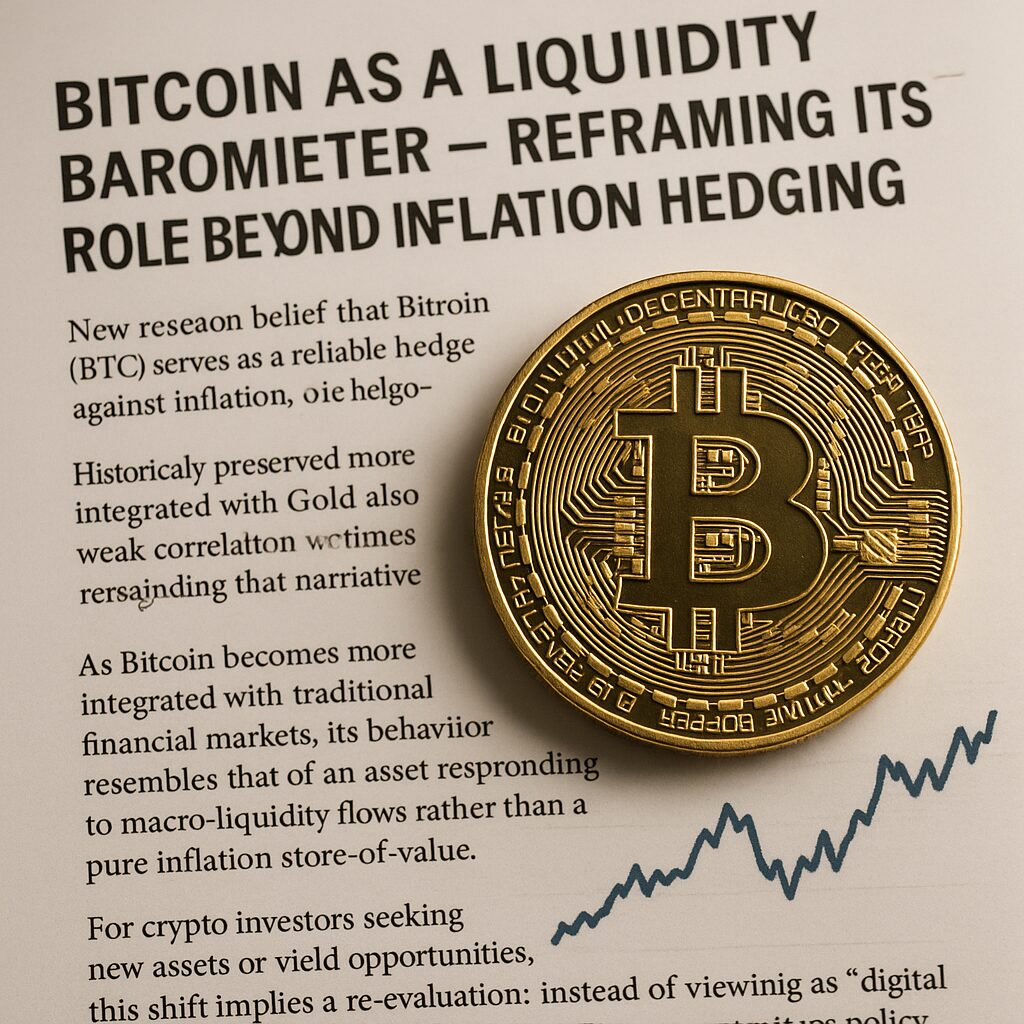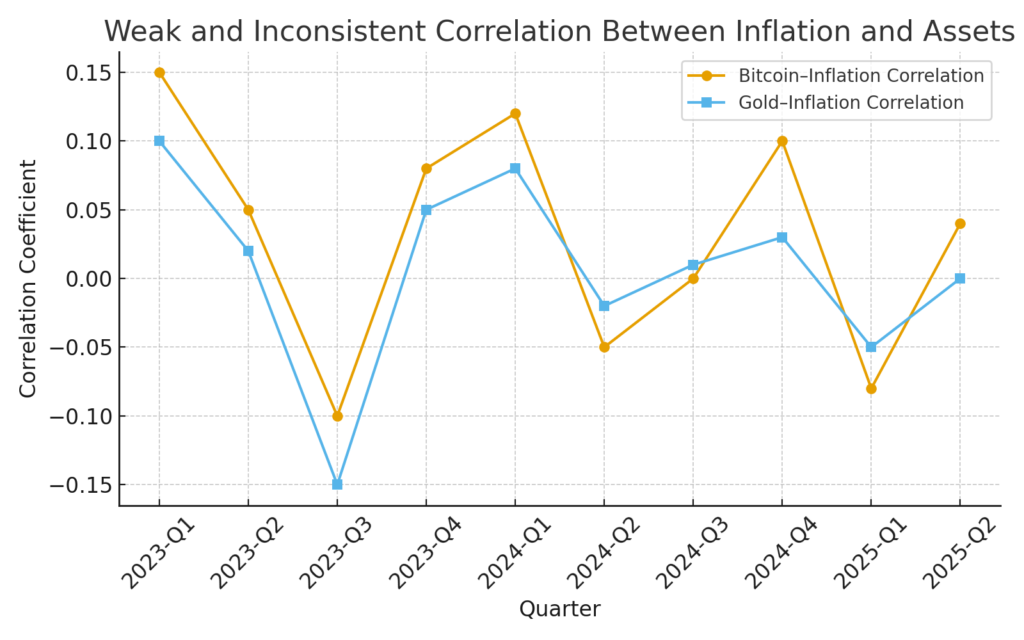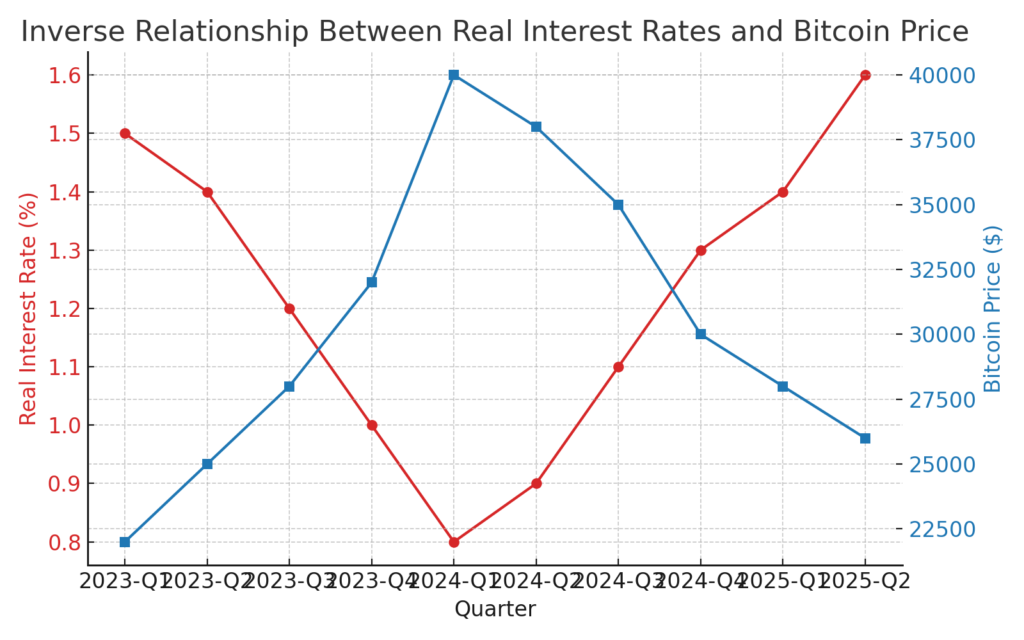
Main Points :
- The common belief that Bitcoin (BTC) serves as a reliable hedge against inflation is challenged by new research from NYDIG.
- Historically perceived inflation-hedge asset Gold also exhibits weak and sometimes negative correlation with inflation, undermining that narrative.
- The more powerful drivers of Bitcoin’s price appear to be real interest rates, money supply, and global liquidity, rather than inflation metrics.
- As Bitcoin becomes more integrated with traditional financial markets, its behavior resembles that of an asset responding to macro-liquidity flows rather than a pure inflation store-of-value.
- For crypto investors seeking new assets or yield opportunities, this shift implies a re-evaluation: instead of viewing Bitcoin as “digital gold for inflation,” consider its sensitivity to monetary policy, dollar strength and global capital flows.
1. The Myth of Inflation Hedging

For years, Bitcoin has been marketed as “digital gold” — a scarce, decentralised asset immune to inflation, a store of value when fiat currencies weaken. But findings from NYDIG suggest that this narrative does not hold up under data scrutiny. Greg Cipolaro, Global Head of Research at NYDIG, states:
“We know the community likes to pitch bitcoin as an inflation hedge, but unfortunately, … the data is just not strongly supportive of that argument.”
Monthly correlation data between inflation indicators (such as CPI or inflation expectations) and Bitcoin’s price show inconsistent and only weak relationships. In plain terms: inflation rising does not reliably mean Bitcoin rising.
This is a meaningful shift in perspective: if inflation is not a major driver, then the asset should not primarily be viewed as a hedge against price level increases or currency debasement.
2. What About Gold?
Gold has long held the mantle of inflation hedge within traditional finance. Yet, NYDIG’s research highlights that gold too shows an inconsistent or even negative correlation with inflation in many periods. Cipolaro notes he was surprised by how often gold’s price moved opposite to inflation.
In practical terms, the conventional wisdom — “when inflation goes up, hold gold” — does not always translate into market reality. In many scenarios, other macro factors (interest rates, real yields) have stronger influence.
3. Liquidity, Interest Rates & Money Supply — The Real Drivers
If inflation doesn’t reliably move Bitcoin or gold, what does? According to the research, key influences include:
- Real interest rates (interest rates adjusted for inflation) — when real rates fall, both gold and Bitcoin tend to benefit progressively.
- Money supply and liquidity conditions — looser monetary policy (higher money supply, weaker dollar) tends to favour these assets.
- US dollar strength/inverse correlation — Bitcoin shows a stronger price response when the US dollar weakens rather than when inflation rises.

In NYDIG’s words:
“If we were to summarise how to think about each asset from a macro factor perspective, it is that gold serves as a real-rate hedge, whereas bitcoin has evolved into a liquidity barometer.”
Thus, for investors, the implication is that Bitcoin’s value is more tied to capital flows, risk sentiment and macro liquidity than to a direct inflation narrative.
4. What This Means for New Crypto Asset Hunters
For an audience actively seeking new crypto assets or revenue sources and practical blockchain applications, here are the take-aways:
- Viewing Bitcoin (and perhaps similarly positioned assets) as liquidity-sensitive rather than inflation-bound changes strategy: you might track interest-rate trends, money supply data, dollar index strength, rather than simply inflation indicators.
- When Bitcoin behaves like a liquidity barometer, its correlation with other risk assets may strengthen — meaning portfolio diversification assumptions might change.
- Assets claiming inflation hedge status must be evaluated with this macro-context in mind: check their sensitivity to real rates, money supply, dollar strength.
- For newer alt-coins or tokens, those positioned around liquidity dynamics (for example, infrastructure tokens, bridging liquidity pools, real-world-asset tokenisation tied to monetary flows) may align better with this paradigm than pure “inflation hedge” claims.
- Blockchain practical uses: if capital flows and liquidity matter, then applications in payments, on-chain financing, real-world-asset tokenisation that tap into macro liquidity shifts may offer stronger revenue and usage potential. For example, tokenising real-world assets when money supply is expansive may yield different behavior than during tightening.
5. Recent Trend & Broader Context
The NYDIG research arrives in a broader context of 2025: globally, central banks are navigating inflation pressures, tapering or pausing rate hikes, while liquidity conditions remain dynamic. The US dollar’s behavior is under focus: a weaker dollar often boosts dollar-priced commodities and crypto.
In crypto markets, institutional flows into Bitcoin (via ETFs, custody services) have increased, embedding Bitcoin more deeply into the traditional finance ecosystem; as that integration grows, so too does the likelihood that macro liquidity and rate factors will influence its price more strongly.
For altcoins and DeFi applications: tokenisation of real-world assets (RWA), decentralised finance lending, on-chain derivatives — these ecosystems become more relevant as liquidity matters. Projects that enable bridging between traditional capital flows and blockchain may capture the underlying macro drivers.
6. Strategic Take-away for Investors & Practitioners
- Re-position Bitcoin in your portfolio not merely as an inflation hedge, but as a barometer of global monetary conditions.
- When real interest rates are tightening, or money supply is contracting, Bitcoin may underperform irrespective of inflation. Conversely, when liquidity is abundant and dollar weak, Bitcoin may gain even if inflation is moderate.
- For new token projects or blockchain products: align value propositions with liquidity tailwinds, capital ingress/egress, and macro-monetary trends, rather than pure inflation protection.
- Use macro-data (interest rates, money supply, FX/dollar index) alongside on-chain metrics (flow of funds, custody accumulation, liquidity pools) to monitor asset potential.
- Educate stakeholders that the narrative is shifting: “digital gold” is not wholly wrong, but its mechanism is more nuanced — Bitcoin is less a fortress against inflation, more a gauge of financial system liquidity.
Conclusion
The recent analysis by NYDIG substantially recalibrates how we think about Bitcoin’s role in portfolios and financial markets. Rather than a reliable hedge against rising consumer prices, Bitcoin appears to mirror the ebb and flow of liquidity, interest-rate policy and dollar strength. For investors in crypto and builders of blockchain infrastructure, this insight invites a more refined lens: seek assets and use-cases that respond to the drivers of capital and macro-monetary momentum. In this light, Bitcoin evolves from digital gold to liquidity barometer, and our strategies should evolve accordingly.

